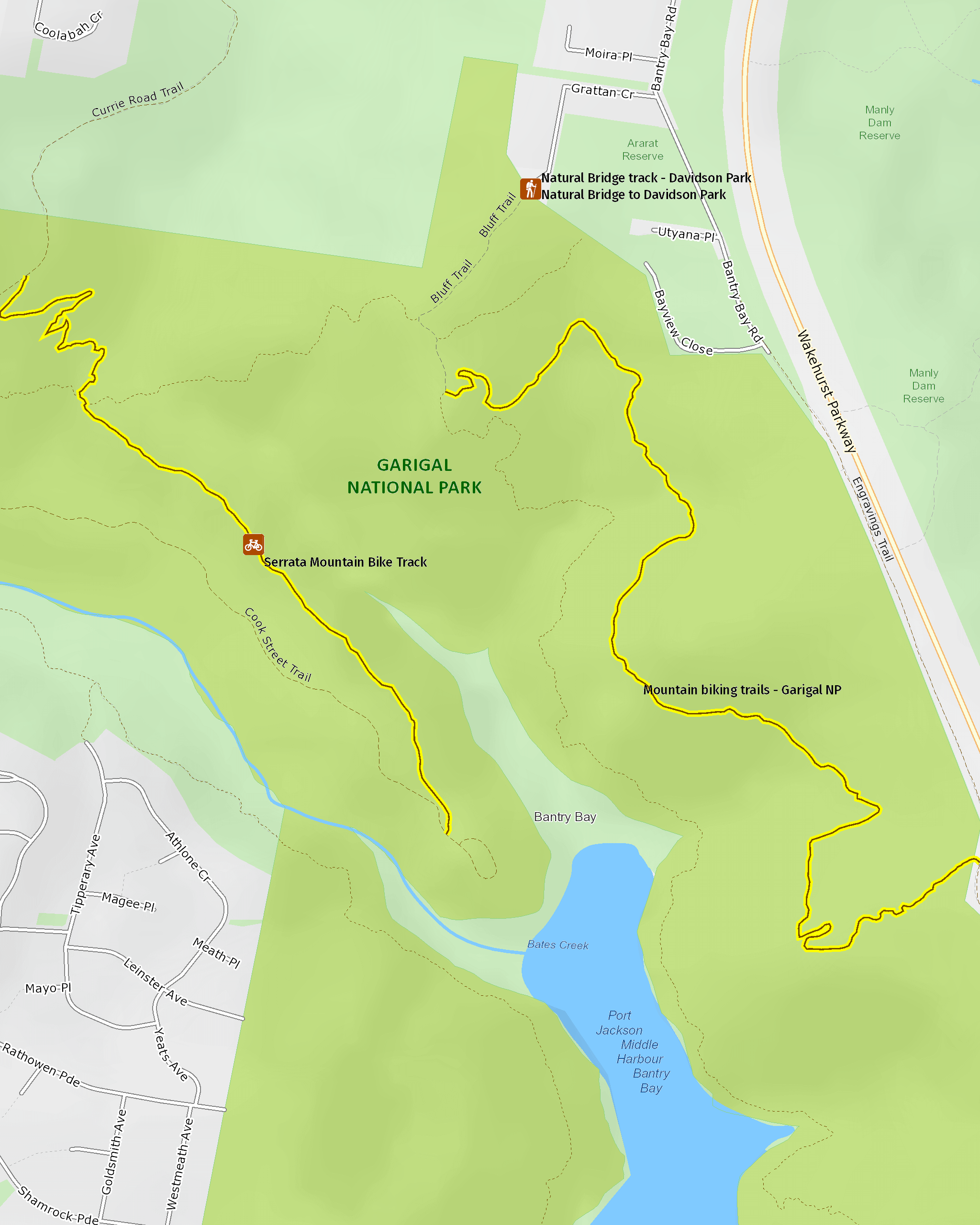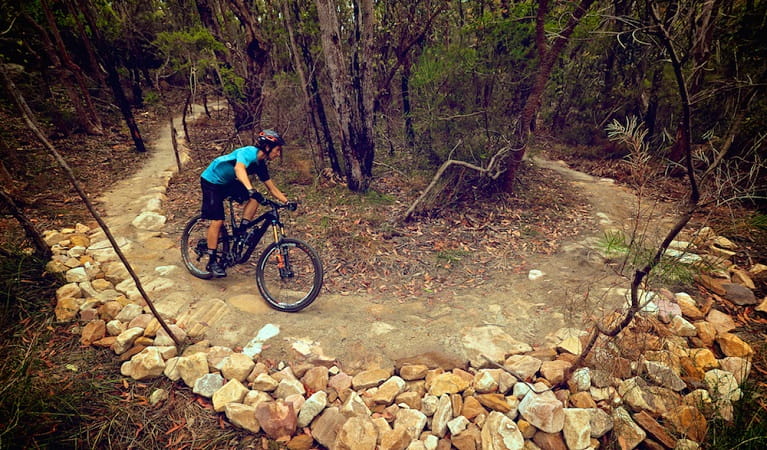Gahnia and Serrata mountain bike trails
Garigal National Park
Overview
Jump on your bike and explore Gahnia and Serrata mountain bike trails in Garigal National Park, a short drive from Sydney’s CBD. The purpose built trails are the perfect place to challenge yourself.
- Distance
- 6.5km of trails
- Time suggested
- 1hr 30min
- Grade
- Hard. Suitable for experienced mountain bike riders.
- Entry fees
-
Park entry fees apply at Davidson Park only
- Opening times
Gahnia and Serrata mountain bike trails are open from sunrise to sunset.
- Please note
- Both trails have an International Mountain Biking Association rating of more difficult (blue), and are suited to experienced riders with a good skill level.
- Riders should follow the International Mountain Bicycling Association responsible riding rules on all trails in Garigal National Park
- For your safety please don’t ride these trails in wet conditions or after heavy rain
- Contact 1300 072 757 (13000 PARKS) to report fallen trees, hazards or damaged trails
- During your bike ride keep an eye out for wildlife which can venture close to the narrow track
Mountain biking in Sydney’s North is taken to the next level with these 2 hand-built single tracks in picturesque Garigal National Park. Nestled in the upper reaches of Bantry Bay, the challenging Gahnia and Serrata mountain bike trails are filled with technical sections and multiple line choices.
You can test your skills on the first 50m, and easily return to nearby shared-use trails if you’re not quite ready.
Serrata mountain bike trail starts from Currie Road trail, where you’ll roll over unique sandstone features before descending 1.5km through tall eucalypts. Then get the heart pumping with a steep uphill climb on Cook Street trail to make this a 2.85km loop.
Why not make a day of it and ride over to Gahnia mountain bike trail, which winds 2.25 km through thick forest before connecting with Engravings trail for the ride back to Bantry Bay Road.
Map

Map legend

Local alerts
For the latest updates on fires, closures and other alerts in this area, see https://www.nationalparks.nsw.gov.au/things-to-do/cycling-trails/gahnia-and-serrata-mountain-bike-trails/local-alerts
General enquiries
- National Parks Contact Centre
- 7am to 7pm daily
- 1300 072 757 (13000 PARKS) for the cost of a local call within Australia excluding mobiles
- parks.info@environment.nsw.gov.au
Park info
- in Garigal National Park in the Sydney and surrounds region
Garigal National Park is open 6am to 6.30pm (8pm during daylight savings) but may have to close at times due to poor weather or fire danger.
-
Park entry fees:
$8 per vehicle per day applies only at Davidson Park only. Day passes are available from on-park pay machines that accept coins and credit cards, and you can also pay for your visit via the Park’nPay app.
Bus: $4.40 per adult, $2.20 per child (per day).
Daily entry fee exemption for teachers and educational supervisors (1 adult per 10 children) applies only for organised and pre-arranged group bookings.
Buy annual pass.
Visitor info
All the practical information you need to know about Gahnia and Serrata mountain bike trails.
Maps and downloads
Learn more
Gahnia and Serrata mountain bike trails is in Garigal National Park. Here are just some of the reasons why this park is special:
Outdoor action

There are countless ways to pass the time in Garigal. Explore the park's trails and tracks on horseback, mountain bike or on foot. If you enjoy water activities, launch your canoe or boat from the ramp at Davidson Park or drop a line in one of the great fishing spots throughout the park, like Middle Harbour, where you can catch flathead, flounder, mullet and bream.
- Cascades trail Cascades trail is ideal for walking, horseriding and mountain biking in Garigal National Park. A medium difficulty walk or ride along a fire trail, it traverses Middle Harbour creek.
- Davidson Park picnic area and boat ramp If you're looking for something to do in Sydney, Davidson Park is a pretty harbourside park with boating and canoeing access, just a short drive from the Sydney CBD.
- Natural Bridge track to Davidson Park This challenging walking track winds through Garigal National Park, and features impressive sandstone rock formations and spectacular water views.
Rich Aboriginal heritage

Aboriginal people have been custodians of the land in Garigal National Park for thousands of years and this connection and legacy is evident throughout the park. Garigal has extensive Aboriginal art sites, with over 100 Aboriginal sites recorded to date, including cave art, rock engravings, shelters, middens and grinding grooves.
- Hawkesbury to harbour walk: Stage 3 Join this great 7hr, 14km guided walk and explore Garigal National Park in northern Sydney. It's the third walk in a series of 5 walks.
- Hawkesbury to harbour walk: Stage 4 Explore the sights of Garigal National Park by joining this 7.5hr, 16km guided walk on the Sydney's lower north shore.
Wartime stories

There are many places of historical interest in the park, such as Bungaroo and the former Bantry Bay Explosives Magazine complex. Both sites played a key role in the early establishment of Sydney and are important reminders of our history since colonisation. Enjoy a walk to Bantry Bay, where you'll see a collection of historically important buildings surrounded by stunning foreshore and bushland views.
- Hawkesbury to harbour walk: Stage 3 Join this great 7hr, 14km guided walk and explore Garigal National Park in northern Sydney. It's the third walk in a series of 5 walks.
- Hawkesbury to harbour walk: Stage 4 Explore the sights of Garigal National Park by joining this 7.5hr, 16km guided walk on the Sydney's lower north shore.
- Pipeline and Bungaroo tracks to Stepping Stones Crossing This short steep walk is one of the most beautiful on Sydney’s upper north shore. Beginning at St Ives, it leads you through Garigal National Park to Middle Harbour creek.
Wildlife haven

Garigal is part of an important wildlife corridor that spans all the way from Sydney Harbour to the national parks of the Blue Mountains. It's the natural habitat for a number of threatened native animal species, such as tiger quolls, broad-headed snakes and red-crowned toadlets, so keep your eyes peeled. If you see a hole in the ground it may be that of the endangered southern brown bandicoot.
- Cascades trail Cascades trail is ideal for walking, horseriding and mountain biking in Garigal National Park. A medium difficulty walk or ride along a fire trail, it traverses Middle Harbour creek.
- Hawkesbury to harbour walk: Stage 3 Join this great 7hr, 14km guided walk and explore Garigal National Park in northern Sydney. It's the third walk in a series of 5 walks.
- Hawkesbury to harbour walk: Stage 4 Explore the sights of Garigal National Park by joining this 7.5hr, 16km guided walk on the Sydney's lower north shore.
- Stepping Stone Crossing to Cascades trail Located in Garigal National Park, Stepping Stone Crossing to Cascades trail is an easy walk that you can enjoy by walking, horse riding or mountain biking.
Plants and animals protected in this park
Animals
-

Eastern water dragon (Intellagama lesueurii lesueurii)
The eastern water dragon is a subaquatic lizard found in healthy waterways along eastern NSW, from Nowra to halfway up the Cape York Pensinsula. It’s believed to be one of the oldest of Australian reptiles, remaining virtually unchanged for over 20 million years.
Plants
-

Grey mangrove (Avicennia marina)
Grey mangrove is the most common and widespread mangrove found within intertidal zones across Australia, and throughout the world. Growing to a height of 3-10m, they thrive best in estuaries with a mix of fresh and salt water. They excrete excess salt through their long thick leaves, and absorb oxygen through their aerial root system.
-

Old man banksia (Banksia serrata)
Hardy Australian native plants, old man banksias can be found along the coast, and in the dry sclerophyll forests and sandstone mountain ranges of NSW. With roughened bark and gnarled limbs, they produce a distinctive cylindrical yellow-green banksia flower which blossoms from summer to early autumn.
-

Grass tree (Xanthorrea spp.)
An iconic part of the Australian landscape, the grass tree is widespread across eastern NSW. These Australian native plants have a thick fire-blackened trunk and long spiked leaves. They are found in heath and open forests across eastern NSW. The grass tree grows 1-5m in height and produces striking white-flowered spikes which grow up to 1m long.
-

Scribbly gum (Eucalyptus haemastoma)
Easily identifiable Australian native plants, scribbly gum trees are found throughout NSW coastal plains and hills in the Sydney region. The most distinctive features of this eucalypt are the ‘scribbles’ made by moth larva as it tunnels between the layers of bark.

